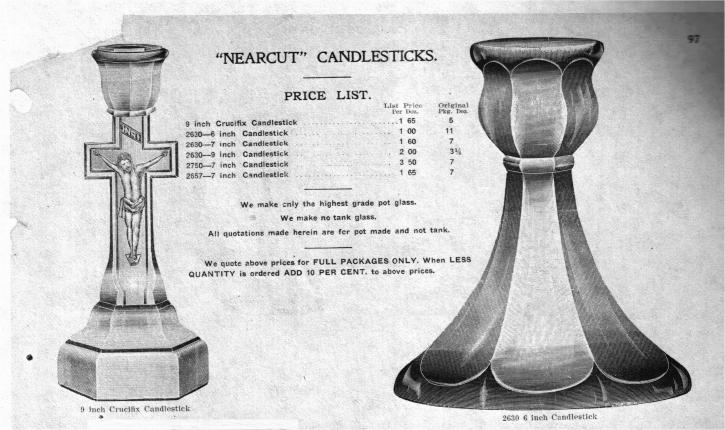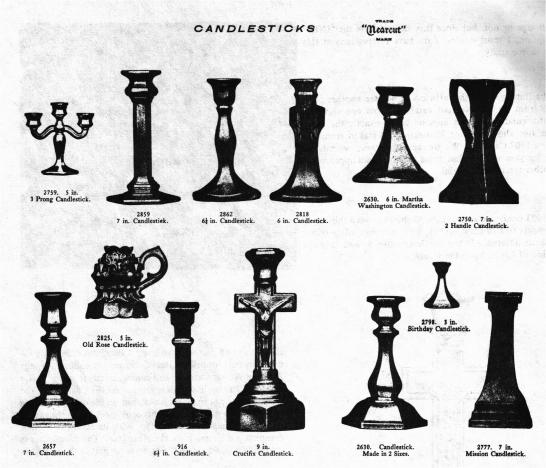Studying the Cambridge Crucifix
by Phyllis
Smith
Issue #83 - March 1980
Trying to write an article concerning a subject you know very little (if anything) about, is no easy task! However, since this has never stopped me before, I will once again plunge right in. Perhaps we can all learn something concerning the Cambridge Crucifix Candlestick!
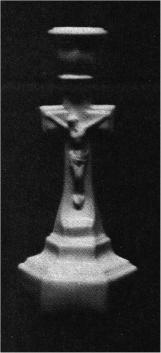 Some months ago I received a letter from our good friend, Elaine
Storck of Minnesota. She enclosed the photo shown at left, and asked the
questions I am quoting here: "I am enclosing a photo of a milk glass
Crucifix candlestick, 9.5" tall. It looks to me to be exactly like the
No. 1 (shown at right) Crucifix Candlestick as shown in the
1903 Catalog of Pressed & Blown Glassware, page 52, by the
Bennetts.
Some months ago I received a letter from our good friend, Elaine
Storck of Minnesota. She enclosed the photo shown at left, and asked the
questions I am quoting here: "I am enclosing a photo of a milk glass
Crucifix candlestick, 9.5" tall. It looks to me to be exactly like the
No. 1 (shown at right) Crucifix Candlestick as shown in the
1903 Catalog of Pressed & Blown Glassware, page 52, by the
Bennetts.
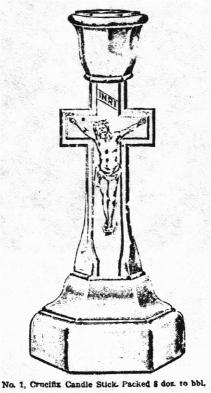 However, our candlestick does not have the INRI inscription.
If you have access to Archer's Glass Candlesticks, book 2, look
on pages 36-37. They show our candlestick (without inscription) and
list it as Cambridge. What is your opinion? If it would be Cambridge of
this early era, would this milk glass be called Carrara? I am confused
by the Carrara term! Does it mean all of the early milk glass, or is it
another color or shade altogether?"
However, our candlestick does not have the INRI inscription.
If you have access to Archer's Glass Candlesticks, book 2, look
on pages 36-37. They show our candlestick (without inscription) and
list it as Cambridge. What is your opinion? If it would be Cambridge of
this early era, would this milk glass be called Carrara? I am confused
by the Carrara term! Does it mean all of the early milk glass, or is it
another color or shade altogether?"
First of all, let me make it perfectly clear that I am not at all sure how to absolutely or positively identify a Cambridge Crucifix Candlestick. But I will make every attempt to present all of the facts that I have available at this time, and allow everyone to draw their own conclusions, just as I will draw mine!
In researching this subject, I have come to the conclusion that the Cambridge Glass Company produced not one, but five slightly different Crucifix candlesticks. They are all illustrated in this article. The one major item I can find that they all seem to have in common is the "INRI" above the head of Christ. But before we get excited and decide that this is a sure-fire way to identify the Cambridge from all others - I am sorry to have to report that this inscription has also been seen on other Crucifix candlesticks that were obviously made by other manufacturers. Evidently many companies made these candlesticks. However, we might draw the conclusion that a candlestick without the "INRI" is not Cambridge. I leave this conclusion up to you. I really don't know!
We do not have Archer's Glass Candlesticks, Book 2, so I cannot comment on this reference. However, we do have their first candlestick book and on page 20, I find their illustration to more closely resemble the #200/34 candlestick. I cannot honestly say if the Archer illustrations are Cambridge or not, but since they do not have the "INRI" inscription, I must confess I do have reservations at this point in our study.
At the end of this article you will see another page taken from an old Nearcut catalog. This one shows a Crucifix candlestick that appears to be exactly the same as the one shown at left (taken from the Bennett 1903 Catalog). We are reprinting part of this catalog page for your information since it has not appeared in any other reference material.
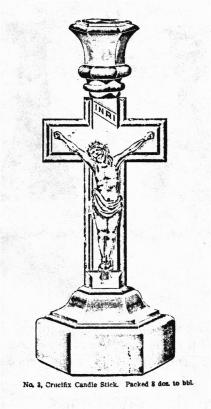 The 1903 Bennett Catalog, page 52 shows us yet a third style of
Crucifix (shown at left). I am sure you will be quick to see the
difference in the candlestick top, as well as in the position of Christ
upon the Cross.
The 1903 Bennett Catalog, page 52 shows us yet a third style of
Crucifix (shown at left). I am sure you will be quick to see the
difference in the candlestick top, as well as in the position of Christ
upon the Cross.
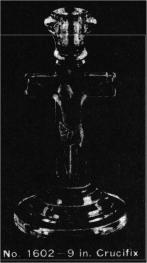 The photo to the right illustrates the latest Crucifix candlestick produced by
the Cambridge Glass Company. It is shown on page 28 in the Welker
Catalog and comes directly from the 1940's catalog. In the illustration
reproduced in this article, the "INRI" does not show very well, but on
the original catalog page you can make it out. This could possibly be
the easiest of all the Crucifixes to identify. With its round base, it
is completely different from the other four. This candlestick is also
shown in Bennett's Color book on plate #48 in crystal.
The photo to the right illustrates the latest Crucifix candlestick produced by
the Cambridge Glass Company. It is shown on page 28 in the Welker
Catalog and comes directly from the 1940's catalog. In the illustration
reproduced in this article, the "INRI" does not show very well, but on
the original catalog page you can make it out. This could possibly be
the easiest of all the Crucifixes to identify. With its round base, it
is completely different from the other four. This candlestick is also
shown in Bennett's Color book on plate #48 in crystal.
The last illustration (shown at the end of this article) is taken from the Welker's Catalog Reprint II, page 119 and they reprinted this page from an old Nearcut catalog.
Now then, we have had a look at all five styles of the Cambridge Crucifix candlestick and we have discovered that Cambridge evidently produced them from as early as 1903 to as late as the early 1940's. Hopefully this information, gathered here on these pages, will be helpful to those of you interested in studying the Cambridge Crucifix! I'm sorry we cannot draw more definite conclusions at this time.
Perhaps we can have a little better luck as we study Elaine's question concerning the color of her candlestick. First of all let me say that if her candlestick is an early Cambridge one, its color would be called Opal. We have a toothpick or match holder Hat like the one shown on page 52 of Bennett's 1903 Catalog in this Opal color and it is quite different from the later Carrara (1923) and the even later Milk Glass (late 1953).
I am not capable of describing to you the distinction between these
three colors (perhaps someone more expert will undertake this at a
later time), 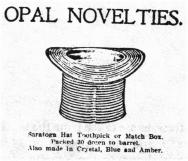 but I can assure you that if you were to place pieces in
each color side-by-side, you would be able to see the difference for
yourself. The best I can do in trying to describe these colors for you
is to use the following illustrations: a hat as shown at left is a
perfect example of the Opal color, a piece of white Cambridge glass
with the Peacock etched on it in gold (ref: Bennett Color Book, plate
#3) would be an example of Carrara, and a piece of Mt. Vernon or Martha
Washington pattern in white glass (ref Welker Catalog Reprint II, pages
1 thru 3) would be a very good example of Milk Glass.
but I can assure you that if you were to place pieces in
each color side-by-side, you would be able to see the difference for
yourself. The best I can do in trying to describe these colors for you
is to use the following illustrations: a hat as shown at left is a
perfect example of the Opal color, a piece of white Cambridge glass
with the Peacock etched on it in gold (ref: Bennett Color Book, plate
#3) would be an example of Carrara, and a piece of Mt. Vernon or Martha
Washington pattern in white glass (ref Welker Catalog Reprint II, pages
1 thru 3) would be a very good example of Milk Glass.
It would seem certain that someone among our membership will have some additional knowledge concerning these candlesticks. If this is the case, we certainly hope they will write to us and share their information. Until this happens, I can only hope that Elaine and the rest of our membership has received some benefit from this "Study" session.
Good luck to everyone! May you be the very first to find a truly identifiable Cambridge Crucifix Candlestick! Let us hear from you.
